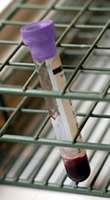- 1: Types of Evidence
- 2: Types of Crime Scenes
- 3: Evidence Collection
- Collection Priority
- Control Samples
- Reference Sample Collection
- Equipment
- Procedures
- Biological Evidence Packaging
- Blood and Body Fluid Collection
- Hair and Fiber
- Wet Stains on Absorbent Surfaces
- Special Situations
- Wet Stains on Nonabsorbent Surfaces
- Dry Stains on Absorbent Surfaces
- Dry Stains on Nonabsorbent Surfaces
- Collecting a Sample From a Smear
- Evidence Marking
- Packaging for Transport
- Chain of Custody
- Preserving Evidence
- Reporting
- Testifying
- Summary
- 04: CODIS

Reference Sample Collection
Home > 3. Evidence Collection > Reference Sample Collection
 Standard/reference samples (oral swabs from all victims) must be collected if a victim is not sure if collected evidence belongs to a suspect. These samples should be collected from all individuals who may be linked to the crime scene where DNA evidence is found or have come in physical contact with the item. Reference samples are used for elimination and comparative analysis. For example, buccal swab samples taken from the suspect and/or victim, a known source, are compared to biological evidence found at the crime scene to eliminate or place them at the scene.
Standard/reference samples (oral swabs from all victims) must be collected if a victim is not sure if collected evidence belongs to a suspect. These samples should be collected from all individuals who may be linked to the crime scene where DNA evidence is found or have come in physical contact with the item. Reference samples are used for elimination and comparative analysis. For example, buccal swab samples taken from the suspect and/or victim, a known source, are compared to biological evidence found at the crime scene to eliminate or place them at the scene.
Buccal Swab
Sterile swabs or other buccal collection devices are rubbed against the inside cheek of the individual's mouth to collect cells for analysis.
Procedure:
- Collect oral swabs from possible suspect(s).
- Collect oral swabs from victim(s).
- Collect oral swabs from known references (those with access to the scene, such as homeowners).
- Do not prewet swab.
- Rub dry swab on the inside of cheek until wet. Collect at least two swabs from cheeks.
- Identify item with donor's name on blood tube or swab box.
- Thoroughly air-dry the swab before packaging.
Liquid Blood Sample Procedure:
- Collect in purple-topped vacuum tubes that contain the preservative ethylenediamine tetraacetic acid.
- Identify item with donor's name on blood tube.
- Refrigerate. Do not freeze or store near high heat (above 100° F) to prevent the glass from fracturing.
- Alert evidence officers of refrigerated samples.
Cigarette Butts:
- Select only the cigarette butts that may be of evidentiary value as a secondary reference sample.
- Insure that the cigarette butts are thoroughly air dried before packaging.
- Do NOT handle with your bare fingers.
- Do NOT include the ashes.



